高考英语情景交际用法总结(完整)
- 格式:docx
- 大小:28.06 KB
- 文档页数:11
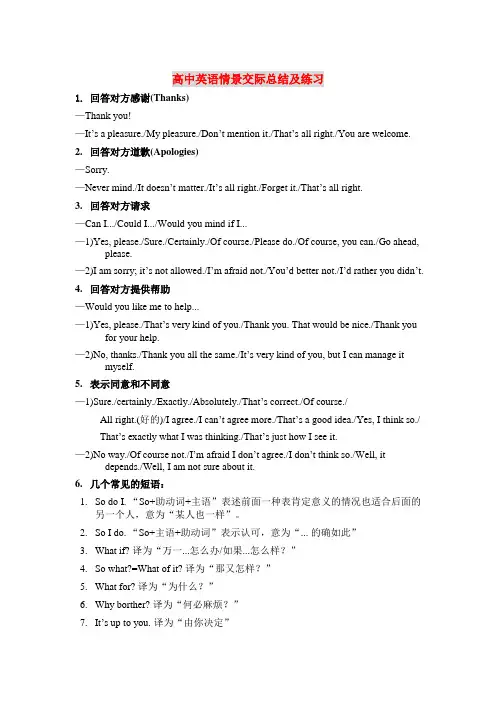
高中英语情景交际总结及练习1.回答对方感谢(Thanks)—Thank you!—It’s a pleasure./My pleasure./Don’t mention it./That’s all right./You are welcome. 2.回答对方道歉(Apologies)—Sorry.—Never mind./It doesn’t matter./It’s all right./Forget it./That’s all right.3.回答对方请求—Can I.../Could I.../Would you mind if I...—1)Yes, please./Sure./Certainly./Of course./Please do./Of course, you can./Go ahead, please.—2)I am sorry; it’s not allowed./I’m afraid not./You’d better not./I’d rather you didn’t.4.回答对方提供帮助—Would you like me to help...—1)Yes, please./That’s very kind of you./Thank you. That would be nice./Thank you for your help.—2)No, thanks./Thank you all the same./It’s very kind of you, but I can manage it myself.5.表示同意和不同意—1)Sure./certainly./Exactly./Absolutely./That’s correct./Of course./All right.(好的)/I agree./I can’t agree more./That’s a good idea./Yes, I think so./ That’s exactly what I was thinking./That’s just how I see it.—2)No way./Of course not./I’m afraid I don’t agree./I don’t think so./Well, it depends./Well, I am not sure about it.6.几个常见的短语:1.So do I. “So+助动词+主语”表述前面一种表肯定意义的情况也适合后面的另一个人,意为“某人也一样”。
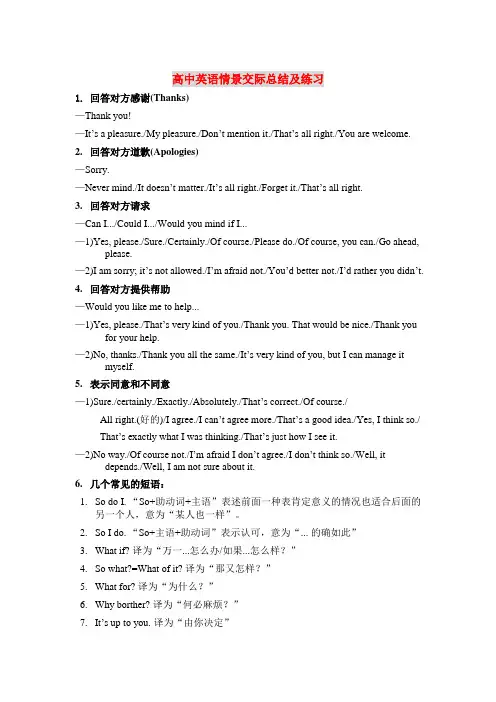
高中英语情景交际总结及练习1.回答对方感谢(Thanks)—Thank you!—It’s a pleasure./My pleasure./Don’t mention it./That’s all right./You are welcome. 2.回答对方道歉(Apologies)—Sorry.—Never mind./It doesn’t matter./It’s all right./Forget it./That’s all right.3.回答对方请求—Can I.../Could I.../Would you mind if I...—1)Yes, please./Sure./Certainly./Of course./Please do./Of course, you can./Go ahead, please.—2)I am sorry; it’s not allowed./I’m afraid not./You’d better not./I’d rather you didn’t.4.回答对方提供帮助—Would you like me to help...—1)Yes, please./That’s very kind of you./Thank you. That would be nice./Thank you for your help.—2)No, thanks./Thank you all the same./It’s very kind of you, but I can manage it myself.5.表示同意和不同意—1)Sure./certainly./Exactly./Absolutely./That’s correct./Of course./All right.(好的)/I agree./I can’t agree more./That’s a good idea./Yes, I think so./ That’s exactly what I was thinking./That’s just how I see it.—2)No way./Of course not./I’m afraid I don’t agree./I don’t think so./Well, it depends./Well, I am not sure about it.6.几个常见的短语:1.So do I. “So+助动词+主语”表述前面一种表肯定意义的情况也适合后面的另一个人,意为“某人也一样”。
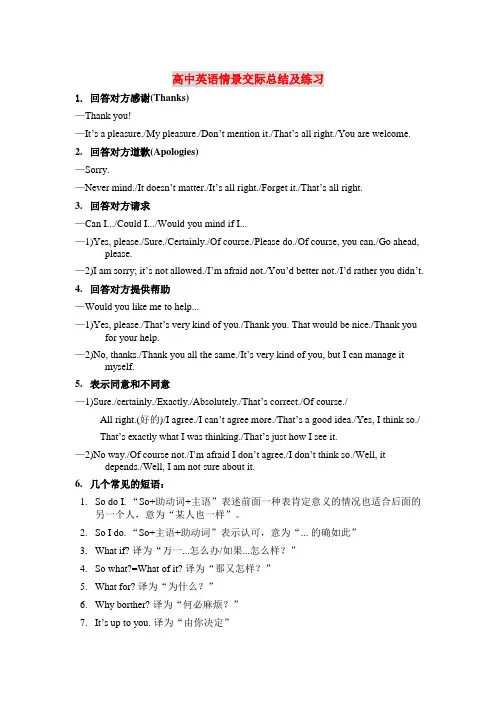
高中英语情景交际总结及练习1.回答对方感谢(Thanks)—Thank you!—It’s a pleasure./My pleasure./Don’t mention it./That’s all right./You are welcome. 2.回答对方道歉(Apologies)—Sorry.—Never mind./It doesn’t matter./It’s all right./Forget it./That’s all right.3.回答对方请求—Can I.../Could I.../Would you mind if I...—1)Yes, please./Sure./Certainly./Of course./Please do./Of course, you can./Go ahead, please.—2)I am sorry; it’s not allowed./I’m afraid not./You’d better not./I’d rather you didn’t.4.回答对方提供帮助—Would you like me to help...—1)Yes, please./That’s very kind of you./Thank you. That would be nice./Thank you for your help.—2)No, thanks./Thank you all the same./It’s very kind of you, but I can manage it myself.5.表示同意和不同意—1)Sure./certainly./Exactly./Absolutely./That’s correct./Of course./All right.(好的)/I agree./I can’t agree more./That’s a good idea./Yes, I think so./ That’s exactly what I was thinking./That’s just how I see it.—2)No way./Of course not./I’m afraid I don’t agree./I don’t think so./Well, it depends./Well, I am not sure about it.6.几个常见的短语:1.So do I. “So+助动词+主语”表述前面一种表肯定意义的情况也适合后面的另一个人,意为“某人也一样”。
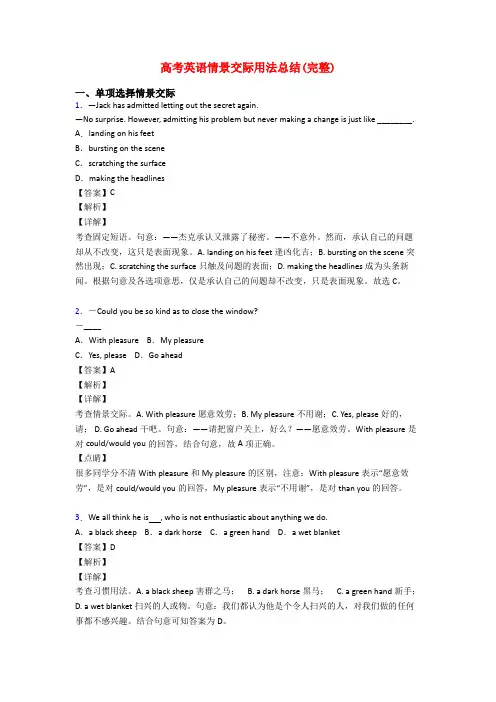
高考英语情景交际用法总结(完整)一、单项选择情景交际1.—Jack has admitted letting out the secret again.—No surprise. However, admitting his problem but never making a change is just like ________. A.landing on his feetB.bursting on the sceneC.scratching the surfaceD.making the headlines【答案】C【解析】【详解】考查固定短语。
句意:——杰克承认又泄露了秘密。
——不意外。
然而,承认自己的问题却从不改变,这只是表面现象。
A. landing on his feet逢凶化吉;B. bursting on the scene突然出现;C. scratching the surface只触及问题的表面;D. making the headlines成为头条新闻。
根据句意及各选项意思,仅是承认自己的问题却不改变,只是表面现象。
故选C。
2.-Could you be so kind as to close the window?-____A.With pleasure B.My pleasureC.Yes, please D.Go ahead【答案】A【解析】【详解】考查情景交际。
A. With pleasure愿意效劳;B. My pleasure不用谢;C. Yes, please好的,请; D. Go ahead干吧。
句意:——请把窗户关上,好么?——愿意效劳。
With pleasure是对could/would you的回答,结合句意,故A项正确。
【点睛】很多同学分不清With pleasure和My pleasure的区别,注意:With pleasure表示“愿意效劳”,是对could/would you的回答,My pleasure表示“不用谢”,是对than you的回答。
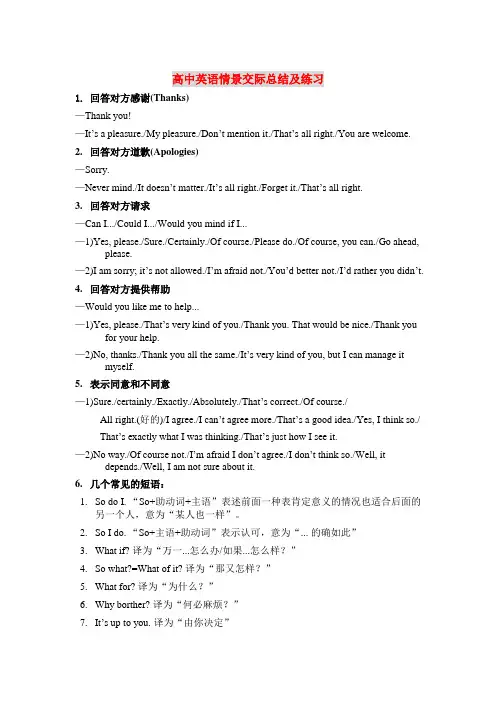
高中英语情景交际总结及练习1.回答对方感谢(Thanks)—Thank you!—It’s a pleasure./My pleasure./Don’t mention it./That’s all right./You are welcome. 2.回答对方道歉(Apologies)—Sorry.—Never mind./It doesn’t matter./It’s all right./Forget it./That’s all right.3.回答对方请求—Can I.../Could I.../Would you mind if I...—1)Yes, please./Sure./Certainly./Of course./Please do./Of course, you can./Go ahead, please.—2)I am sorry; it’s not allowed./I’m afraid not./You’d better not./I’d rather you didn’t.4.回答对方提供帮助—Would you like me to help...—1)Yes, please./That’s very kind of you./Thank you. That would be nice./Thank you for your help.—2)No, thanks./Thank you all the same./It’s very kind of you, but I can manage it myself.5.表示同意和不同意—1)Sure./certainly./Exactly./Absolutely./That’s correct./Of course./All right.(好的)/I agree./I can’t agree more./That’s a good idea./Yes, I think so./ That’s exactly what I was thinking./That’s just how I see it.—2)No way./Of course not./I’m afraid I don’t agree./I don’t think so./Well, it depends./Well, I am not sure about it.6.几个常见的短语:1.So do I. “So+助动词+主语”表述前面一种表肯定意义的情况也适合后面的另一个人,意为“某人也一样”。
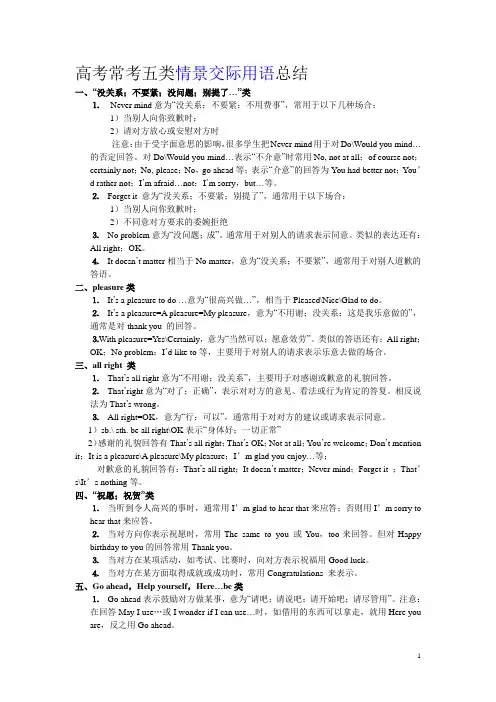
高考常考五类情景交际用语总结一、“没关系;不要紧;没问题;别提了…”类⒈ Never mind意为“没关系;不要紧;不用费事”,常用于以下几种场合:1)当别人向你致歉时;2)请对方放心或安慰对方时注意:由于受字面意思的影响,很多学生把Never mind用于对Do\Would you mind…的否定回答。
对Do\Would you mind…表示“不介意”时常用No, not at all;of course not;certainly not;No, please;No,go ahead等;表示“介意”的回答为You had better not;You’d rather not;I’m afraid…not;I’m sorry,but…等。
⒉Forget it 意为“没关系;不要紧;别提了”,通常用于以下场合:1)当别人向你致歉时;2)不同意对方要求的委婉拒绝⒊No problem意为“没问题;成”。
通常用于对别人的请求表示同意。
类似的表达还有:All right;OK。
⒋It doesn’t matter相当于No matter,意为“没关系;不要紧”,通常用于对别人道歉的答语。
二、pleasure类⒈It’s a pleasure to do …意为“很高兴做…”,相当于Pleased\Nice\Glad to do。
⒉It’s a pleasure=A pleasure=My pleasure,意为“不用谢;没关系;这是我乐意做的”,通常是对thank you 的回答。
⒊With pleasure=Yes\Certainly,意为“当然可以;愿意效劳”。
类似的答语还有:All right;OK;No problem;I’d like to等,主要用于对别人的请求表示乐意去做的场合。
三、all right 类⒈That’s all right意为“不用谢;没关系”,主要用于对感谢或歉意的礼貌回答。
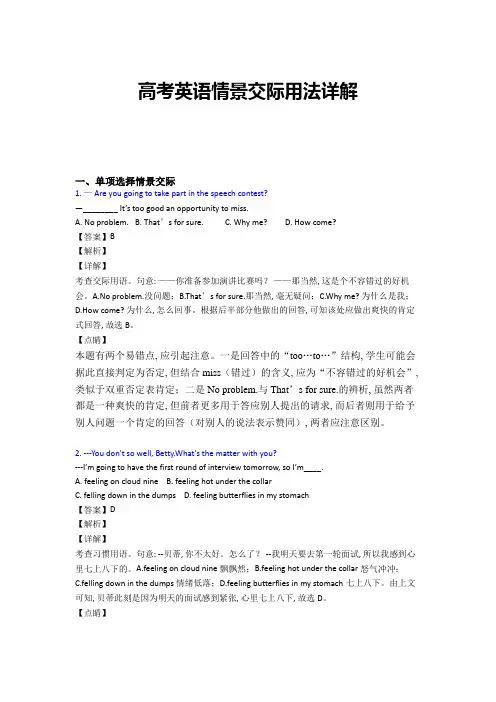
高考英语情景交际用法详解一、单项选择情景交际1. — Are you going to take part in the speech contest?—________ It’s too good an opportunity to miss.A. No problem.B. That’s for sure.C. Why me?D. How come?【答案】B【解析】【详解】考查交际用语。
句意: ——你准备参加演讲比赛吗?——那当然, 这是个不容错过的好机会。
A.No problem.没问题;B.That’s for sure.那当然, 毫无疑问;C.Why me? 为什么是我;D.How come? 为什么, 怎么回事。
根据后半部分他做出的回答, 可知该处应做出爽快的肯定式回答, 故选B。
【点睛】本题有两个易错点, 应引起注意。
一是回答中的“too…to…”结构, 学生可能会据此直接判定为否定, 但结合miss(错过)的含义, 应为“不容错过的好机会”, 类似于双重否定表肯定;二是No problem.与That’s for sure.的辨析, 虽然两者都是一种爽快的肯定, 但前者更多用于答应别人提出的请求, 而后者则用于给予别人问题一个肯定的回答(对别人的说法表示赞同), 两者应注意区别。
2. ---You don't so well, Betty.What's the matter with you?---I’m going to have the first round of interview tomorrow, so I’m____.A. feeling on cloud nineB. feeling hot under the collarC. felling down in the dumpsD. feeling butterflies in my stomach【答案】D【解析】【详解】考查习惯用语。

高中英语情景交际总结及练习1.回答对方感谢(Thanks)—Thank you!—It’s a pleasure./My pleasure./Don’t mention it./That’s all right./You are welcome. 2.回答对方道歉(Apologies)—Sorry.—Never mind./It doesn’t matter./It’s all right./Forget it./That’s all right.3.回答对方请求—Can I.../Could I.../Would you mind if I...—1)Yes, please./Sure./Certainly./Of course./Please do./Of course, you can./Go ahead, please.—2)I am sorry; it’s not allowed./I’m afraid not./You’d better not./I’d rather you didn’t.4.回答对方提供帮助—Would you like me to help...—1)Yes, please./That’s very kind of you./Thank you. That would be nice./Thank you for your help.—2)No, thanks./Thank you all the same./It’s very kind of you, but I can manage it myself.5.表示同意和不同意—1)Sure./certainly./Exactly./Absolutely./That’s correct./Of course./All right.(好的)/I agree./I can’t agree more./That’s a good idea./Yes, I think so./ That’s exactly what I was thinking./That’s just how I see it.—2)No way./Of course not./I’m afraid I don’t agree./I don’t think so./Well, it depends./Well, I am not sure about it.6.几个常见的短语:1.So do I. “So+助动词+主语”表述前面一种表肯定意义的情况也适合后面的另一个人,意为“某人也一样”。
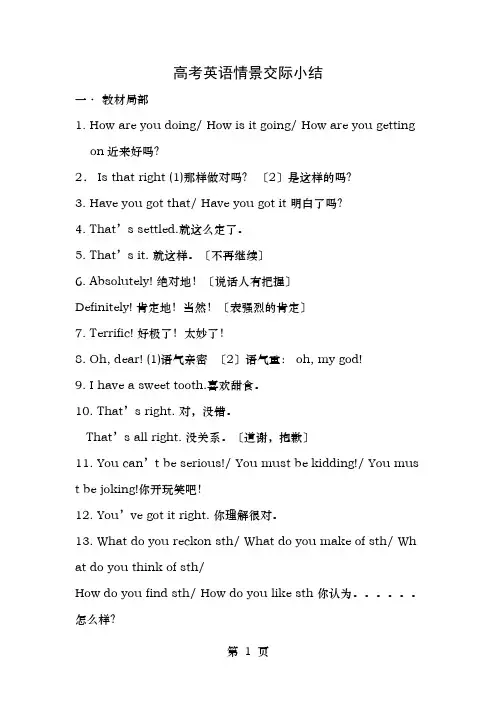
高考英语情景交际小结一·教材局部1. How are you doing/ How is it going/ How are you gettingon近来好吗?2. Is that right (1)那样做对吗?〔2〕是这样的吗?3. Have you got that/ Have you got it 明白了吗?4. That’s settled.就这么定了。
5. That’s it. 就这样。
〔不再继续〕6. Absolutely! 绝对地!〔说话人有把握〕Definitely! 肯定地!当然!〔表强烈的肯定〕7. Terrific! 好极了!太妙了!8. Oh, dear! (1)语气亲密〔2〕语气重: oh, my god!9. I have a sweet tooth.喜欢甜食。
10. That’s right. 对,没错。
That’s all right. 没关系。
〔道谢,抱歉〕11. You can’t be serious!/ You must be kidding!/ You mus t be joking!你开玩笑吧!12. You’ve got it right. 你理解很对。
13. What do you reckon sth/ What do you make of sth/ Wh at do you think of sth/How do you find sth/ How do you like sth 你认为。
怎么样?14. Don’t change a thing. 无需改变。
15. What’s on (1) 你在干什么?〔2〕发生什么事了?〔3〕上映什么?〔电影,电视〕16. Thanks for the compliment! 承蒙夸奖。
17. The thing is……问题是。
18. Good for you. 真有你的!很好!19. Whereabouts is that 那是在哪里?20. What’s sth like 询问对。
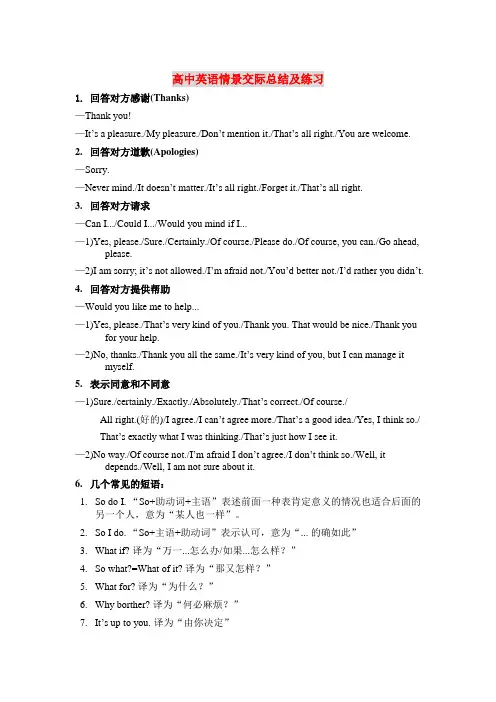
高中英语情景交际总结及练习1.回答对方感谢(Thanks)—Thank you!—It’s a pleasure./My pleasure./Don’t mention it./That’s all right./You are welcome. 2.回答对方道歉(Apologies)—Sorry.—Never mind./It doesn’t matter./It’s all right./Forget it./That’s all right.3.回答对方请求—Can I.../Could I.../Would you mind if I...—1)Yes, please./Sure./Certainly./Of course./Please do./Of course, you can./Go ahead, please.—2)I am sorry; it’s not allowed./I’m afraid not./You’d better not./I’d rather you didn’t.4.回答对方提供帮助—Would you like me to help...—1)Yes, please./That’s very kind of you./Thank you. That would be nice./Thank you for your help.—2)No, thanks./Thank you all the same./It’s very kind of you, but I can manage it myself.5.表示同意和不同意—1)Sure./certainly./Exactly./Absolutely./That’s correct./Of course./All right.(好的)/I agree./I can’t agree more./That’s a good idea./Yes, I think so./ That’s exactly what I was thinking./That’s just how I see it.—2)No way./Of course not./I’m afraid I don’t agree./I don’t think so./Well, it depends./Well, I am not sure about it.6.几个常见的短语:1.So do I. “So+助动词+主语”表述前面一种表肯定意义的情况也适合后面的另一个人,意为“某人也一样”。
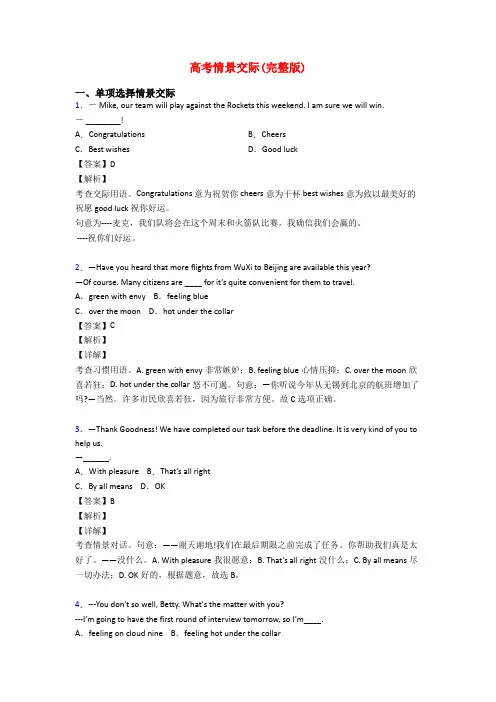
高考情景交际(完整版)一、单项选择情景交际1.- Mike, our team will play against the Rockets this weekend. I am sure we will win.- ________!A.Congratulations B.CheersC.Best wishes D.Good luck【答案】D【解析】考查交际用语。
Congratulations 意为祝贺你 cheers意为干杯 best wishes 意为致以最美好的祝愿 good luck 祝你好运。
句意为----麦克,我们队将会在这个周末和火箭队比赛,我确信我们会赢的。
----祝你们好运。
2.—Have you heard that more flights from WuXi to Beijing are available this year?—Of course. Many citizens are ____ for it’s quite convenient for them to travel.A.green with envy B.feeling blueC.over the moon D.hot under the collar【答案】C【解析】【详解】考查习惯用语。
A. green with envy非常嫉妒;B. feeling blue心情压抑;C. over the moon欣喜若狂;D. hot under the collar怒不可遏。
句意:—你听说今年从无锡到北京的航班增加了吗?—当然。
许多市民欣喜若狂,因为旅行非常方便。
故C选项正确。
3.—Thank Goodness! We have completed our task before the deadline. It is very kind of you to help us.—______.A.With pleasure B.That’s all rightC.By all means D.OK【答案】B【解析】【详解】考查情景对话。
高中英语情景交际总结及练习1.回答对方感谢(Thanks)—Thank you!—It’s a pleasure./My pleasure./Don’t mention it./That’s all right./You are welcome. 2.回答对方道歉(Apologies)—Sorry.—Never mind./It doesn’t matter./It’s all right./Forget it./That’s all right.3.回答对方请求—Can I.../Could I.../Would you mind if I...—1)Yes, please./Sure./Certainly./Of course./Please do./Of course, you can./Go ahead, please.—2)I am sorry; it’s not allowed./I’m afraid not./You’d better not./I’d rather you didn’t.4.回答对方提供帮助—Would you like me to help...—1)Yes, please./That’s very kind of you./Thank you. That would be nice./Thank you for your help.—2)No, thanks./Thank you all the same./It’s very kind of you, but I can manage it myself.5.表示同意和不同意—1)Sure./certainly./Exactly./Absolutely./That’s correct./Of course./All right.(好的)/I agree./I can’t agree more./That’s a good idea./Yes, I think so./ That’s exactly what I was thinking./That’s just how I see it.—2)No way./Of course not./I’m afraid I don’t agree./I don’t think so./Well, it depends./Well, I am not sure about it.6.几个常见的短语:1.So do I. “So+助动词+主语”表述前面一种表肯定意义的情况也适合后面的另一个人,意为“某人也一样”。
高中英语情景交际总结及练习1.回答对方感谢(Thanks)—Thank you!—It’s a pleasure./My pleasure./Don’t mention it./That’s all right./You are welcome. 2.回答对方道歉(Apologies)—Sorry.—Never mind./It doesn’t matter./It’s all right./Forget it./That’s all right.3.回答对方请求—Can I.../Could I.../Would you mind if I...—1)Yes, please./Sure./Certainly./Of course./Please do./Of course, you can./Go ahead, please.—2)I am sorry; it’s not allowed./I’m afraid not./You’d better not./I’d rather you didn’t.4.回答对方提供帮助—Would you like me to help...—1)Yes, please./That’s very kind of you./Thank you. That would be nice./Thank you for your help.—2)No, thanks./Thank you all the same./It’s very kind of you, but I can manage it myself.5.表示同意和不同意—1)Sure./certainly./Exactly./Absolutely./That’s correct./Of course./All right.(好的)/I agree./I can’t agree more./That’s a good idea./Yes, I think so./ That’s exactly what I was thinking./That’s just how I see it.—2)No way./Of course not./I’m afraid I don’t agree./I don’t think so./Well, it depends./Well, I am not sure about it.6.几个常见的短语:1.So do I. “So+助动词+主语”表述前面一种表肯定意义的情况也适合后面的另一个人,意为“某人也一样”。
高中英语情景交际总结及练习1.回答对方感谢(Thanks)—Thank you!—It’s a pleasure./My pleasure./Don’t mention it./That’s all right./You are welcome. 2.回答对方道歉(Apologies)—Sorry.—Never mind./It doesn’t matter./It’s all right./Forget it./That’s all right.3.回答对方请求—Can I.../Could I.../Would you mind if I...—1)Yes, please./Sure./Certainly./Of course./Please do./Of course, you can./Go ahead, please.—2)I am sorry; it’s not allowed./I’m afraid not./You’d better not./I’d rather you didn’t.4.回答对方提供帮助—Would you like me to help...—1)Yes, please./That’s very kind of you./Thank you. That would be nice./Thank you for your help.—2)No, thanks./Thank you all the same./It’s very kind of you, but I can manage it myself.5.表示同意和不同意—1)Sure./certainly./Exactly./Absolutely./That’s correct./Of course./All right.(好的)/I agree./I can’t agree more./That’s a good idea./Yes, I think so./ That’s exactly what I was thinking./That’s just how I see it.—2)No way./Of course not./I’m afraid I don’t agree./I don’t think so./Well, it depends./Well, I am not sure about it.6.几个常见的短语:1.So do I. “So+助动词+主语”表述前面一种表肯定意义的情况也适合后面的另一个人,意为“某人也一样”。
最新英语情景交际用法总结(完整)一、单项选择情景交际1.—Would you please keep an eye on my bag? I want to go to the washroom.—______. It will be safe with me. It doesn't matter.A.It doesn't matter B.Go ahead C.Forget it D.It's my pleasure 【答案】B【解析】【详解】考查交际用语。
句意:——请帮我看一下包好吗?我想去洗手间。
——去吧,放我这很安全,没问题。
A. It doesn’t matter没关系,没什么,与后面重复;B. Go ahead去吧;C. Forget it不必在意,休想;D. It’s my pleasure我的荣幸。
根据下文“It will be safe with me. It doesn’t matter.”可知,答应看护包裹,结合各选项意思,故选B。
2.--Was he _____when he got an A+ in the English exam?--Absolutely! He even went to the cinema with his classmates to celebrate it .A.On cloud nine B.hot under the collarC.Down in the dumps D.as cool as a cucumber【答案】A【解析】【详解】考查习惯用语。
句意:——当他在英语考试中得了A+时,他是不是非常高兴?——当然!他甚至和同学一起去看电影院庆祝。
A. On cloud nine乐不可支;B. hot under the collar愤怒的;C. Down in the dumps气馁;D. as cool as a cucumber冷静沉着。
高中英语情景交际总结及练习1.回答对方感谢(Thanks)—Thank you!—It’s a pleasure./My pleasure./Don’t mention it./That’s all right./You are welcome. 2.回答对方道歉(Apologies)—Sorry.—Never mind./It doesn’t matter./It’s all right./Forget it./That’s all right.3.回答对方请求—Can I.../Could I.../Would you mind if I...—1)Yes, please./Sure./Certainly./Of course./Please do./Of course, you can./Go ahead, please.—2)I am sorry; it’s not allowed./I’m afraid not./You’d better not./I’d rather you didn’t.4.回答对方提供帮助—Would you like me to help...—1)Yes, please./That’s very kind of you./Thank you. That would be nice./Thank you for your help.—2)No, thanks./Thank you all the same./It’s very kind of you, but I can manage it myself.5.表示同意和不同意—1)Sure./certainly./Exactly./Absolutely./That’s correct./Of course./All right.(好的)/I agree./I can’t agree more./That’s a good idea./Yes, I think so./ That’s exactly what I was thinking./That’s just how I see it.—2)No way./Of course not./I’m afraid I don’t agree./I don’t think so./Well, it depends./Well, I am not sure about it.6.几个常见的短语:1.So do I. “So+助动词+主语”表述前面一种表肯定意义的情况也适合后面的另一个人,意为“某人也一样”。
高中英语情景交际总结及练习1.回答对方感谢(Thanks)—Thank you!—It’s a pleasure./My pleasure./Don’t mention it./That’s all right./You are welcome. 2.回答对方道歉(Apologies)—Sorry.—Never mind./It doesn’t matter./It’s all right./Forget it./That’s all right.3.回答对方请求—Can I.../Could I.../Would you mind if I...—1)Yes, please./Sure./Certainly./Of course./Please do./Of course, you can./Go ahead, please.—2)I am sorry; it’s not allowed./I’m afraid not./You’d better not./I’d rather you didn’t.4.回答对方提供帮助—Would you like me to help...—1)Yes, please./That’s very kind of you./Thank you. That would be nice./Thank you for your help.—2)No, thanks./Thank you all the same./It’s very kind of you, but I can manage it myself.5.表示同意和不同意—1)Sure./certainly./Exactly./Absolutely./That’s correct./Of course./All right.(好的)/I agree./I can’t agree more./That’s a good idea./Yes, I think so./ That’s exactly what I was thinking./That’s just how I see it.—2)No way./Of course not./I’m afraid I don’t agree./I don’t think so./Well, it depends./Well, I am not sure about it.6.几个常见的短语:1.So do I. “So+助动词+主语”表述前面一种表肯定意义的情况也适合后面的另一个人,意为“某人也一样”。